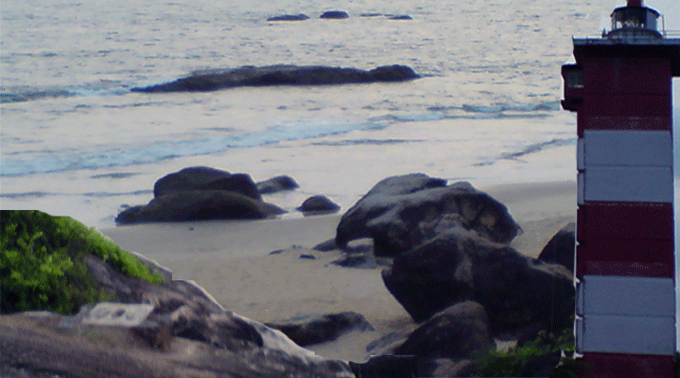
A photo-montage of Torathakall beach west of NITK campus.
The place names often change with changes in the attitude and customs of the people living around the region. The place name Surathkal presently gives an impression as if it is ‘Surutha’ (=first) ‘Kall’ (=stone). People have often erroneously assumed that it perhaps once represented the first milestone towards Mangalore or something like that.
Vijayanagar period
An stone inscription found in the courtyard of the Kadire Manjunatha temple, Mangalore dated ca.1386 CE, belonging to the period of chieftain Banki Alupendra, who was ruling under the Vijayanagara King Harihararaya, has described the place Surathkal as Turithakali.The ‘kali’ end-form must be an writing error and possibly it was meant Turithakall.
Turithakall <.Torathakall
The inscription rather confirms that the place was known as ‘Turitha-kall’ during 14th century CE. This corresponds closely to the ancient Tulu name of the place Toratha-kall. Even today older folks designate this town as Toratha-kall! And the Turithakall form in the Kannada inscription is only a stylized version of the old Tulu word Torathakall.
As usual to understand the meaning of the place, you have to look into the natural setting of the town, devoid of modern concrete jungles that have been imposed upon it in the recent years.
Wave-washed Rocks
The Surathkal beach west of National Institute of Technology Karnataka (NITK; formerly known as KREC-Karnataka Regional College of Engineering, Surathkal) holds the key for the meaning of the word Torathakall.
On the NITK beach, we find several large to medium sized dome shaped exposures of gray granite-gneiss rocks that have been turned jet black on their exteriors due to onset of marine waves and coastal rains. On one large exposure we find an ancient temple dedicated to Lord Sadashiva. On another exposure, there is a modern light house built to guide the ships safely into the New Mangalore harbour.
There are other numerous smaller exposures of granite in the beach strip and in the littoral zone on which the proceeding and receding sea waves play with incessantly often swirling around the rock exposures. This particular scenery of play of waves with the rocks must have mesmerized our ancestors.
The name Toratha kall refers directly to the swirling action of waves on the rocks.
The Tulu place name Torathakall is often shortened to Torth-al.
Magic of ‘torapuni’
The words ‘Tere’ or ‘Sire’ refers to sea waves in Tulu language. But the meaning of the word ‘torapuni’ is far more meaningful in the context. The verb ‘torapu’ refers to the ancient practice of protection against evils: it is a primitive form of sorcery or psycho-somatic healing magic.
In the olden days, grandmothers used to conduct the art of ‘torapuni’ on children who were unusually afraid or sick due to psycho-somatic reasons. The art of ‘torapuni’ consists of taking a small stone in the fist and circling it around the head of the infected child, in clockwise direction, a few times, corresponding with chanting of spells that wished all that evils that affected the child should go away or vanish. Finally the stone use for ‘torapuni’ or ‘torat deepuni’ is thrown away and it is considered that all the evil effects are removed from the child. There are several other variants of the torapuni act which essentially is magical practice of the ancient Tulu people designed for the psycho-somatic well being of the children.
For those who stand and watch the play of waves on the beach it appears as if the swirling waves do the magic act of ‘torapuni ‘on the rock exposures strewn in the beach of Torathikall or the torat-kall.
Sire Kallina deva
Ramesh Puthran of Suratkal writes vachanas in 'Mogaveera' (magazine). He terminates the vachanas in the pen-name of 'Sira kallina deva' referring to Lord Sadashiva of Surathkal beach. ‘Sira’, ‘sire’ or 'tere' means sea waves. The Sadashiva temple is located on the rocky mound, which is washed perennially by the incessant waves of the Arabian Sea.
®
Acknowledgement
The post is written in collaboration with Hosabettu Viswanath



Brilliant piece. Never knew there was so much history behind the word origins of Surathkal.
ReplyDeleteIts is a common misconception that Surathkal just means "Surath - face" and "kal- stone", meaning headstone.
Although this could be true, the way you have analysed seems more sensible.